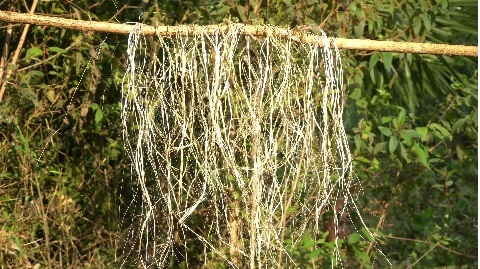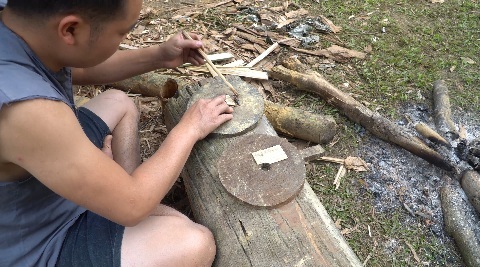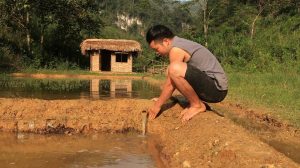Primitive Skills: Piston Bellows (Fuigo)
In the project of producing iron from natural stone, creating more modern tools from iron to improve productivity and work efficiency to replace the primitive stone tools.
The last time I smelted iron, I collected some iron and created an ax, the ax I’m using today. Since using that iron ax, primitive skills have been completed more easily and effectively than rudimentary tools. That’s why I decided to cast iron again and take more iron to make more tools.
This time I won’t use the original blower like the last time, but I will use my iron ax to build a much more powerful air pump than the previous one.
In this video, “primitive skills” will make wooden wind pumps, the materials include: A 1-meter-long log with a diameter of 30cm to make the wind pipe, a wooden stick 1m long 10cm wide, 3 pieces of wood 2 pieces to make two caps of the pipe, the other one is for a plunger head, about 100g of wild chicken feathers, forest bark, tree sap, etc. along with some small wooden pieces and wild ropes. taken from the forest.
Because the video length is so long, in this video, “primitive skills” focus very carefully on the first part of the plunger, but the other parts only briefly tell you.
Principle of operation of the wind pump: 2 pump heads are 2 holes with holes and are covered by a flexible piece of bamboo inside the pump. 2 pieces of bamboo operate when pulling the plunger, the end of the plunger moves inwards, the piece of bamboo is opened and wind from outside enters the pump. On the other hand, when pushing the plunger, the piston head moves closer to the bamboo piece and pushes the wind to make the piece of bamboo close, the wind is passed through the 2 holes beside the two pump heads and outwards. The 2 pieces of bamboo on both ends of the pump operate alternately, when one side is closed and one side is open, ie when pulling or pushing the plunger evenly let the wind out.
The first part of the pump (or duct) this section we will cut a log about 1m long and 30cm diameter. Then create an inner hole by placing red charcoal in the head and blowing the wind to heat the coal and gradually burn it into a hole. In order for the wind to be transmitted together, we create an outer slot and make a hole on either side of the channel with a pump so that the wind comes from inside the pipe. The trench is sealed with a piece of wood with a hole in the middle to bring out the wind. Next are 2 pieces of round caps at the two pump heads: The outer cover is made a hole in the middle of the lid to get air; The front cover is made of 2 holes, the center hole is made for the purpose of threading a plunger bar, the remaining hole is for wind. The plunger lever is made of a straight wooden stick about 1.2m long and round with the size of a thumb. The inside of the pump is attached to a piece of wood, the outside creates a handle to pump. This piece of wood combines with a piece of wood inside the pipe called a plunger.
In this article, “primitive skills” will cover details of skills, jobs, and the entire content in the video. I started walking into the forest, finding a long fallen tree in the forest, the outer bark and rotting wood, leaving only the hardware inside, I tried using the ax to try and found the wood inside was still very good. Well, the hardware inside is about 30cm in diameter, enough for me to make a round wooden plate with a diameter of about 20 to 25cm. I proceeded to cut and clean the surrounding trees, bushes and chop a long section about 30cm. Unfortunately, when I was halfway there, my ax flew off the handle, because the long ax had been degraded, so I had to go back to make a new ax, when I finished, I turned. It was tight. until broken and take it home.
After that, I took my basket to the forest to look for sap and Rami. I have come to a root, I don’t know the scientific name of this tree but the sap is very good. Then I cut a bamboo tube and made a cup. Make misaligned cuts on the trunk, use the cup to catch its plastic. Then cut a piece of young bamboo, take 5-6 Rami root and bring them home. As you can see, the sap after being stuck is very firm on my hand.
My next job is to chop Rami trees, take their roots to the garden. Dig deep into the holes about 20 cm deep and put the roots down and compress to allow it to grow. This rami is characterized by a height of 1-2m, leaves large by the hand, bulging in the middle, pointed at the ends, serrated edges and bark very firm, when removing mucus, the rest are fibers that act like sewing threads in modern times now.

(Rami yarn)
I proceeded to remove the tops and remove its leaves, peel and use the ax to remove the mucus into extremely strong fibers. Let dry and will be used in the next segment.
Right now the “primitive skills” begin to cut the piece of wood cut and process the previous piece into a 3cm-thick piece of wood. Measure with the plunger, draw a circle a little smaller than the top of the plunger. Using an ax tightly around the edge of the circle and forming a round piece of wood, it can be easily inserted into the plunger called the plunger cap. Use an ax to cut a groove in the middle of the rim and a hole in the middle of the plunger cap. Insert the push bar into the plunger cover called the plunger.
After preparing the pistons, fibers (Rami bark) and baskets of wild chicken were collected during hunting (see how to hunt wild chicken in the “video“). Choose and arrange wild chicken feathers into small bundles to fit the plunger groove, then proceed to fasten. Choose long fibers to weave into a larger and stronger yarn. Conducting to tie the bundles of wild chicken feathers on the rope, the bundles are tied together on the string. While the sap is burned to make fire, to use this resin, we have to boil the plastic until it condenses, then it has high adhesion, and especially this plastic must be used in the process. boil, after cooling will harden very hard plastic, so it is suitable to paste something. After you have tied the hairs, proceed to string the string in the plunger and tighten it, cut off the excess string. Try placing the plunger cap on the plunger and moving in and out of the pump head smoothly. Then chop the piece of young bamboo brought earlier and form 2 pieces flat, thin and 3x5cm wide. Each piece is folded a small piece. Take the cooked plastic and apply it to the position of the edge of the hole to cover as shown:

(how to use sap)
Stick one end of the piece of bamboo to form a flexible flap in the direction of push or inlet. Do the same with the other cap.
After everything is ready, proceed to install the pump: the front cover is mounted on the plunger bar first, insert the push rod into the plunger cover for sure. Insert the plunger cap into the pump and secure the pump cap in front of you, and then pump on the other side. Carry out a test pump if the plunger moves stably in the pump, adding a bamboo cover to cover the two sides of the pump. Pad the piece of wood to collect wind, using two rings wrapped with rattan from the two pump heads to the position where the piece of wood is held tightly.
After complete assembly of parts, we conduct inspections. No, wind is detected at the connection points between the parts so the amount of wind collected is not strong enough. Therefore, the “primitive skills” must take soil and water to cover the gaps.
As you can see, when all the wind is put in the same door, it is very strong, it can be said that the amount of wind collected hundreds of times more than the original blower.
Therefore, the “primitive skills” has completed a powerful air pump furnace for its iron upgrading project.
(Read the next section here)
Thank you for viewing the article on “primitivekills.net”
See you in the next posts!





Please provide a link of you making the cylinder thank you.
How many liters of air are given per stroke? How many liters per minute/hour?